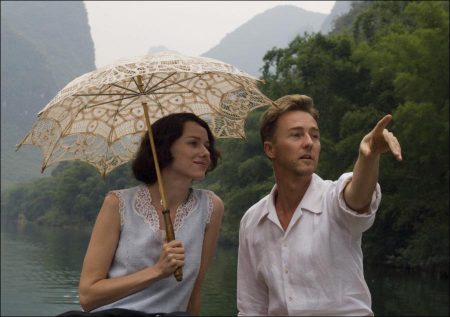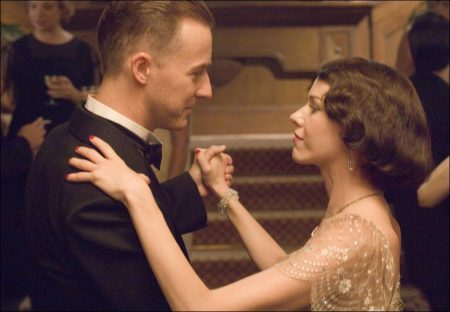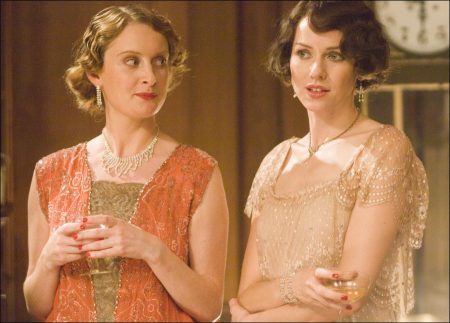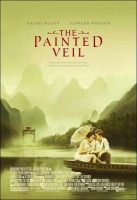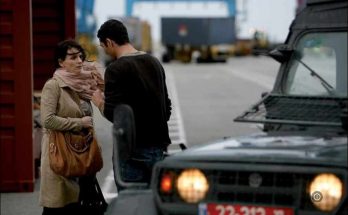Tagline: Sometimes the greatest journey is the distance between two people.
Based on the classic novel by Somerset Maugham, The Painted Veil is a love story set in the 1920s that tells the tale of a young English couple, Walter, a middle class doctor and Kitty, an upper-class woman, who get married for the wrong reasons and relocate to Shanghai, where she falls in love with someone else.
When he uncovers her infidelity, in an act of vengeance, he accepts a job in a remote village in China ravaged by a deadly epidemic, and takes her along. Their journey brings meaning to their relationship and gives them purpose in one of the most remote and beautiful places on earth.
Kitty is an upper class London socialite closing in on an age when a proper lady must find a husband. To remain unwed much longer would be highly unbecoming, not to mention humiliating for her socially conscious mother. Bored with her lifestyle anyway and yearning escape, Kitty accepts a proposal of marriage from Dr. Walter Fane, a quiet, serious bacteriologist who moves the new couple to Shanghai.
In the strange city — which is blooming into the center of popular culture, political intrigue and vice in China — the Fanes venture out into British colonial society, where they are introduced to English Vice Consul Charles Townsend. While Walter dedicates himself to his work and to his new wife, Kitty embarks on an adulterous affair with Charlie. After Walter learns of her indiscretion, he accepts a job in a remote village in China ravaged by the deadly cholera epidemic, and forces a despondent Kitty to accompany him.
About the Production
In the fall of 2004, Edward Norton telephoned Naomi Watts—once again—about playing Kitty Fane in The Painted Veil. This time, he was determined to enlist the actress— for five years, Norton, screenwriter Ron Nyswaner and producer Sara Colleton had been developing an adaptation of W. Somerset Maugham’s 1925 novel, and they were hoping to finally get it produced.
Unfortunately, Watts, a 2004 Best Actress Oscar nominee who had also recently completed roles in The Ring Two and Marc Forster’s Stay, had just finished a grueling eightmonth shoot in Australia for King Kong and wasn’t eager to begin another film. “I was tired, and I wasn’t sure that I wanted to work again for at least that part of the year,” she admits. But after speaking at length with the persuasive Norton, “Suddenly my promise to myself about not working went out the window,” she laughs. “I always knew this book would make a great film.”
“I spoke to Naomi toward the end of 2004,” remembers Norton, who has earned two Oscar nominations—one for his very first role in a motion picture. “I said, ‘Look, we could both do this next summer. Let’s really put our heads together and think of a director we’d be excited to work with. Let’s do it.’”
It had been a long journey, however, to get to this point. The film began its road to the big screen in 1995 when screenwriter Ron Nyswaner began looking for his next project. Nyswaner had written the screenplay for the seminal 1993 film Philadelphia, which had gone on to receive widespread acclaim and earned the writer an Oscar nomination for Best Original Screenplay.
“I’ve been intrigued by Maugham’s work ever since I saw Of Human Bondage as a kid,” he explains, referring to the film adaptation of Maugham’s most famous book, which starred Bette Davis and Leslie Howard in its 1934 incarnation. “I was fascinated by the melodramatic story of obsessive love. I went through his books one by one, and I finally read The Painted Veil. It was this book of Maugham’s that haunted me more than any other.
In a conversation with producer Sara Colleton, Nyswaner referenced The Painted Veil as one of his favorite books. Sara revealed that she had in fact spent the last year trying to secure rights to the book with the Maugham estate. It was destiny.
“We talked about Maugham’s book and how it deals with the topic of sexual love versus spiritual love more honestly than any piece of literature today,” she recalls. “We both knew then that we really wanted to make the film version.”
Maugham, who was born in Paris in 1874 but grew up in England, spent years as a medical student before becoming one of the 20th century’s most popular novelists. Nyswaner admired the way this particular story by the author transformed from one about revenge into one about redemption.
“On the surface, the story is direct and dramatic: a man with a broken heart seeks to punish his adulterous wife. The journey of this ill-matched couple is fraught with sexual and psychological tension,” he points out. “The story takes a surprising twist, however, as the characters come to see themselves—and each other—in a new light; the psychological thriller becomes a spiritual journey.”
With Nyswaner on board, Colleton began work on an early draft of the script with him. Portions of the book that explain Kitty’s backstory and shed light on her decision to marry Walter were condensed into a brief prologue of flashbacks. After three years of intense rewriting and development — during which producer Jean-François Fonlupt was also brought on board.” Colleton says.
In 1999, Norton’s first impressions of the script were overwhelmingly positive. “Ron adapted it wonderfully,” he remembers. “I thought it was a great piece of writing.” Norton, a talented filmmaker in his own right and a self-described Sinophile, immediately responded to the complex character of bacteriologist Walter Fane and his mercurial relationship with wife Kitty. “Walter and Kitty’s emotional journey as a couple is compelling in the script, especially how they transcend their own negativity about each other and resuscitate their relationship,” he explains. “Walter has to find his way to forgiveness. This story really hit all the numbers for me,” he adds, “because these are some the most challenging issues in life.”
Despite Norton’s fondness for the script, for various reasons, “We couldn’t get the film made at that time,” says the actor. Norton would go on to make his feature film directorial debut, Keeping the Faith, which he also produced and starred in alongside Ben Stiller and Jenna Elfman. But even from the back burner, The Painted Veil seemed to preoccupy Norton as intensely as it had haunted Ron Nyswaner.
“Ron’s dialogue and his sense of Maugham’s themes were so sophisticated and well done—it was one of those scripts that stayed in my brain,” says the actor. “Eventually, I called Ron and Sara and said, ‘Listen, why don’t we take another crack at this?’”
Norton came on board as a producer late in 1999, which injected the project with new vigor. “Edward worked ceaselessly, year after year, to guide this project towards production,” praises Nyswaner. The two collaborated for the next six months on the script in an effort to, in Norton’s words, “liberate it from the novel a little bit. We wanted to open it up to China somewhat and to create a romantic transcendence in the film, which doesn’t exist in the novel, and take the Walter-Kitty relationship farther.”
Norton, who had studied Chinese history as a Yale undergraduate, was a valuable resource for Nyswaner during the rewriting process. “It was with his inspiration and guidance that I began to explore the work Walter does in China, which is completely absent from the book,” explains the screenwriter.
The revision lent depth and breadth to Walter, which only heightened Norton’s interest in the character. “The way in which Walter gets broken by China is very tragic, but very interesting to me,” he comments. “Walter represents the forces of British Colonialism during that era. People were going into other countries and trying to make them over as their own. Walter also represents Western rationalism—the Western scientific mind that believes that if people would just embrace the way the West does things, they’d have it so much easier.”
By the same token, according to Norton, Walter is a symbol of “the frustration that the Western mindset feels when it encounters a cultural gulf, or resistance from people who don’t want to be told how to pursue their own history.”
The passionate bacteriologist is ultimately forced to confront the fact that he won’t help the Chinese if he simply imposes his vision of the world on them. “You’ve got to work with people and through people,” says Norton. “You have to honor their own cultural, social, political, and historical reality. Otherwise, it’s all empty.”
One of the first people to be interested was Naomi Watts, who was shooting The Ring in 2001. “Edward was attached to The Painted Veil, but there was no director at that time,” she says. “I fell in love with the script from my first read. I thought it was an incredible love story and a wonderful character.” “Kitty was clearly the first thing that drew me to the story,” she continues. “At first, she just floated by and took whatever came to her. She had no deep inner life and nothing tangible to put herself into.”
After she marries Walter Fane and finds herself in Mei-tan-fu, “She goes on a great journey of self-discovery and learns how to access this other side of herself,” says Watts. “She starts realizing that there’s more to life than the way she’s been leading it thus far.” “Kitty is a person who has never really looked at the world outside of the narrow confines of herself and her social circle,” adds Edward Norton. “China blows her vision of the world wide open and forces her to get engaged in things that are bigger than she is. When she does that, she finds grace. She grows up as a person.”
But despite Watts’ unequivocal enthusiasm about the character and the project, even then, “It wasn’t set up properly to go into production,” she says.
“Between Naomi being busy and me being busy and various directors dancing around the project but then not being available, it just wasn’t going to happen in 2001,” agrees Norton. “We had so many false starts with this project. We could never get all of the elements together at the same time.”
In 2001, Bob Yari and Mark Gordon became involved with The Painted Veil together with Mark Gill, who at the time was president of Gordon and Yari’s Stratus Film Company. When Gill left to create Warner Independent Pictures in the fall of 2003, he took the film with him and continued to shepherd it with the assistance of Stratus’ Robert Katz. The addition of Yari, Gordon, Gill and Katz to the roster breathed new life into the project—to the extent that Edward Norton felt confident enough in the fall of 2004 to put in that fateful call to Naomi Watts.
“It’s been a long journey,” Watts admits. “Edward has been involved for six years, and I’ve been attached for four. It’s great that at the last minute it came together, and all the right elements fell into place.”
One of these elements was John Curran. The director’s name came up during conversations between Norton and Watts regarding possible helmers for The Painted Veil. “Naomi had just done We Don’t Live Here Anymore with John,” says Norton, referring to Curran’s acclaimed 2004 drama that also starred Mark Ruffalo, Laura Dern and Peter Krause. “I had seen it, and I asked Naomi how her experience was during filming. She went on and on about how much she enjoyed it and what great performances John got out of people.”
“John is fantastic to work with,” raves Watts of her longtime friend, a native New Yorker and Syracuse University alum who moved to Australia in 1986. “He came to me a few years back to do We Don’t Live Here Anymore, and it was a difficult piece of material. But the way he talked about it made me jump on board.
“There are difficult aspects to The Painted Veil as well,” she continues. “But I know that John is able to explore flawed characters without judgment.” Watts contacted Curran, and he and Norton met for lunch right after New Year’s in 2005. “It was exciting, because I got along with John right off the bat,” recalls Norton. “And John and Naomi already had a great history, so it was one of those really lucky breaks.
“There were many times in the course of the six years that I’ve been working on this project that I felt it was never going to happen,” he confesses. “It was worth the wait because when it finally clicked, it clicked with the right people. We made a strong collaborative team.”
Curran felt the same way. “I think in the initial meetings about a project, you’re really testing how you communicate and bounce ideas off each other,” says Curran. “Edward and I immediately hit it off. We talked for a long time about the film and other things. He had an abundance of ideas, and he was very open to exchanging ideas with me and working through them. He was very passionate about it.”
“John was so responsive to the material,” says Norton. “It was apparent to me right away that he was the right person to do this. Not only was he interested in the themes, but he seemed ready to take on a film of larger scope. We needed that, because China was going to be a challenge. He seemed hungry for it. “It finally came together,” says Norton. “At that point, it really took off.”
The Painted Veil (2006)
Directed by: John Curran
Starring: Naomi Watts, Edward Norton, Diana Rigg, Catherine An, Liev Schreiber, Bin Wu, Toby Jones, Gesang Meiduo, Lorraine Laurence, Zoe Telford, Maggie Steed
Screenplay by Ron Nyswaner
Hroduction Design by: Juhua Tu
Cinematography by: Stuart Dryburgh
Film Editing by Alexandre de Franceschi
Set Decoration by: Peta Lawson
Costume Design by Ruth Myers
Art Direction by: Mei Kunping, Xinran Tu, Yanrong Xing
Music by: Alexandre Desplat
Distributed by: Warner Bros. Türkiye
Release Date: January 19, 2007
Views: 112
